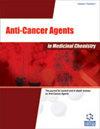金丝桃苷抑制 RNF8 介导的 β-catenin 核转运,从而抑制 PD-L1 的表达和前列腺癌的发生
IF 2.6
4区 医学
Q3 CHEMISTRY, MEDICINAL
Anti-cancer agents in medicinal chemistry
Pub Date : 2024-02-02
DOI:10.2174/0118715206289246240110044931
引用次数: 0
摘要
背景:金丝桃苷是从贯叶连翘中分离出来的一种黄酮醇苷,对癌细胞有抑制作用;但它对前列腺癌(PCa)的作用仍不清楚。因此,我们研究了金丝桃苷在体外和体内的抗 PCa 作用及其内在机制。目的:本研究旨在探索金丝桃苷抗 PCa 的机制。方法:采用 3-(4,5-二甲基-2-噻唑基)-2,5-二苯基溴化四氮唑(MTT)、透孔法和流式细胞术检测 PCa 细胞的生长、侵袭和凋亡。免疫印迹分析、免疫荧光、免疫沉淀和定量实时 PCR(qRT-PCR)用于分析金丝桃苷的抗肿瘤机制。结果金丝桃苷抑制了PCa细胞的生长、侵袭和细胞周期,并诱导细胞凋亡。此外,RING 手指蛋白 8(RNF8)是一种组装 K63 多泛素化链的 E3 连接酶,被预测为金丝桃苷的直接靶标,并被金丝桃苷下调。高甙对RNF8的下调阻碍了β-catenin的核转位,破坏了Wnt/β-catenin通路,从而降低了靶基因c-myc、细胞周期蛋白D1和程序性死亡配体1(PD-L1)的表达。PD-L1水平的降低有助于诱导体外Jurkat细胞产生免疫力。最后,体内研究表明,金丝桃苷能显著缩小肿瘤大小,抑制 PD-L1 和 RNF8 的表达,并诱导皮下小鼠模型肿瘤组织中的细胞凋亡。结论金丝桃苷通过减少RNF8蛋白、抑制β-catenin的核转位和破坏Wnt/β-catenin通路,进而减少PD-L1的表达和提高Jurkat细胞的免疫力来发挥抗PCa作用。本文章由计算机程序翻译,如有差异,请以英文原文为准。
Hyperoside Inhibits RNF8-mediated Nuclear Translocation of β-catenin to Repress PD-L1 Expression and Prostate Cancer
Background: Hyperoside is a flavonol glycoside isolated from Hypericum perforatum L. that has inhibitory effects on cancer cells; however, its effects on prostate cancer (PCa) remain unclear. Therefore, we studied the anti-PCa effects of hyperoside and its underlying mechanisms in vitro and in vivo. Aim: This study aimed to explore the mechanism of hyperoside in anti-PCa. Methods: 3-(4,5-Dimethyl-2-Thiazolyl)-2,5-Diphenyl Tetrazolium Bromide (MTT), transwell, and flow cytometry assays were used to detect PCa cell growth, invasion, and cell apoptosis. Immunoblot analysis, immunofluorescence, immunoprecipitation, and quantitative real-time PCR (qRT-PCR) were used to analyze the antitumor mechanism of hyperoside. Results: Hyperoside inhibited PCa cell growth, invasion, and cell cycle and induced cell apoptosis. Furthermore, RING finger protein 8 (RNF8), an E3 ligase that assembles K63 polyubiquitination chains, was predicted to be a direct target of hyperoside and was downregulated by hyperoside. Downregulation of RNF8 by hyperoside impeded the nuclear translocation of β-catenin and disrupted the Wnt/β-catenin pathway, which reduced the expression of the target genes c-myc, cyclin D1, and programmed death ligand 1 (PD-L1). Decreased PD-L1 levels contributed to induced immunity in Jurkat cells in vitro. Finally, in vivo studies demonstrated that hyperoside significantly reduced tumor size, inhibited PD-L1 and RNF8 expression, and induced apoptosis in tumor tissues of a subcutaneous mouse model. Conclusion: Hyperoside exerts its anti-PCa effect by reducing RNF8 protein, inhibiting nuclear translocation of β-catenin, and disrupting the Wnt/β-catenin pathway, in turn reducing the expression of PD-L1 and improving Jurkat cell immunity.
求助全文
通过发布文献求助,成功后即可免费获取论文全文。
去求助
来源期刊

Anti-cancer agents in medicinal chemistry
ONCOLOGY-CHEMISTRY, MEDICINAL
CiteScore
5.10
自引率
3.60%
发文量
323
审稿时长
4-8 weeks
期刊介绍:
Formerly: Current Medicinal Chemistry - Anti-Cancer Agents.
Anti-Cancer Agents in Medicinal Chemistry aims to cover all the latest and outstanding developments in medicinal chemistry and rational drug design for the discovery of anti-cancer agents.
Each issue contains a series of timely in-depth reviews and guest edited issues written by leaders in the field covering a range of current topics in cancer medicinal chemistry. The journal only considers high quality research papers for publication.
Anti-Cancer Agents in Medicinal Chemistry is an essential journal for every medicinal chemist who wishes to be kept informed and up-to-date with the latest and most important developments in cancer drug discovery.
 求助内容:
求助内容: 应助结果提醒方式:
应助结果提醒方式:


